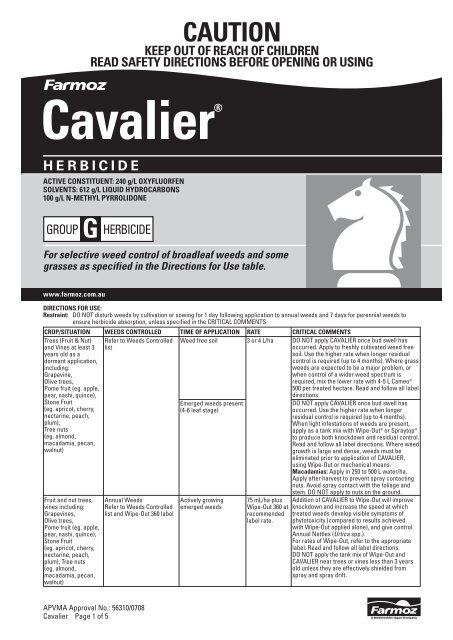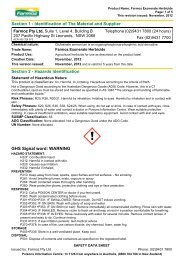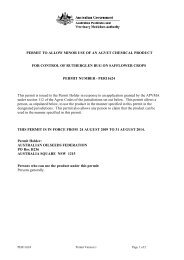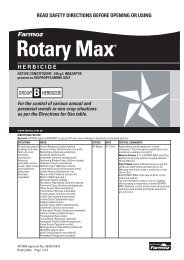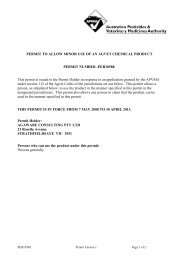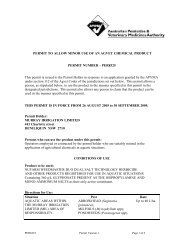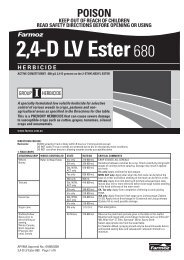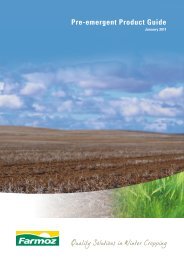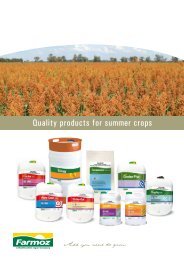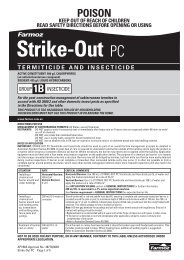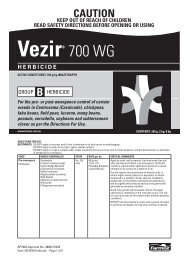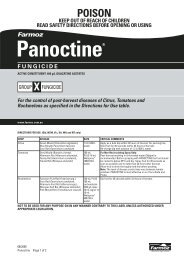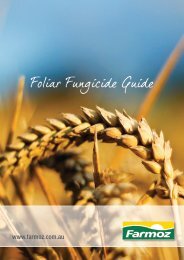View Label - Farmoz
View Label - Farmoz
View Label - Farmoz
Create successful ePaper yourself
Turn your PDF publications into a flip-book with our unique Google optimized e-Paper software.
Cavalier®<br />
ACTIVE CONSTITUENT: 240 g/L OXYFLUORFEN<br />
SOLVENTS: 612 g/L LIQUID HYDROCARBONS<br />
100 g/L N-METHYL PYRROLIDONE<br />
For selective weed control of broadleaf weeds and some<br />
grasses as specified in the Directions for Use table.<br />
www.farmoz.com.au<br />
CAUTION<br />
KEEP OUT OF REACH OF CHILDREN<br />
READ SAFETY DIRECTIONS BEFORE OPENING OR USING<br />
HERBICIDE<br />
GROUP G HERBICIDE<br />
DIRECTIONS FOR USE:<br />
Restraint: DO NOT disturb weeds by cultivation or sowing for 1 day following application to annual weeds and 7 days for perennial weeds to<br />
ensure herbicide absorption, unless specified in the CRITICAL COMMENTS<br />
CROP/SITUATION WEEDS CONTROLLED TIME OF APPLICATION RATE<br />
CRITICAL COMMENTS<br />
Trees (Fruit & Nut)<br />
and Vines at least 3<br />
years old as a<br />
dormant application,<br />
including:<br />
Grapevine,<br />
Olive trees,<br />
Pome fruit (eg. apple,<br />
pear, nashi, quince),<br />
Stone Fruit<br />
(eg. apricot, cherry,<br />
nectarine, peach,<br />
plum),<br />
Tree nuts<br />
(eg. almond,<br />
macadamia, pecan,<br />
walnut)<br />
Fruit and nut trees,<br />
vines including:<br />
Grapevines,<br />
Olive trees,<br />
Pome fruit (eg. apple,<br />
pear, nashi, quince),<br />
Stone Fruit<br />
(eg. apricot, cherry,<br />
nectarine, peach,<br />
plum), Tree nuts<br />
(eg. almond,<br />
macadamia, pecan,<br />
walnut)<br />
Refer to Weeds Controlled<br />
list<br />
Annual Weeds<br />
Refer to Weeds Controlled<br />
list and Wipe-Out 360 label<br />
APVMA Approval No.: 56310/0708<br />
Cavalier Page 1 of 5<br />
Weed free soil DO NOT apply CAVALIER once bud swell has<br />
occurred. Apply to freshly cultivated weed free<br />
soil. Use the higher rate when longer residual<br />
control is required (up to 4 months). Where grass<br />
weeds are expected to be a major problem, or<br />
when control of a wider weed spectrum is<br />
required, mix the lower rate with 4-5 L Cameo ®<br />
3 or 4 L/ha<br />
500 per treated hectare. Read and follow all label<br />
directions.<br />
Emerged weeds present<br />
DO NOT apply CAVALIER once bud swell has<br />
(4-6 leaf stage)<br />
occurred. Use the higher rate when longer<br />
residual control is required (up to 4 months).<br />
When light infestations of weeds are present,<br />
apply as a tank mix with Wipe-Out ® or Spraytop ®<br />
to produce both knockdown and residual control.<br />
Read and follow all label directions. Where weed<br />
growth is large and dense, weeds must be<br />
eliminated prior to application of CAVALIER,<br />
using Wipe-Out or mechanical means.<br />
Macadamias: Apply in 250 to 500 L water/ha.<br />
Apply after harvest to prevent spray contacting<br />
nuts. Avoid spray contact with the foliage and<br />
stem. DO NOT apply to nuts on the ground.<br />
Actively growing<br />
emerged weeds<br />
75 mL/ha plus<br />
Wipe-Out 360 at<br />
recommended<br />
label rate.<br />
Addition of CAVALIER to Wipe-Out will improve<br />
knockdown and increase the speed at which<br />
treated weeds develop visible symptoms of<br />
phytotoxicity (compared to results achieved<br />
with Wipe-Out applied alone), and give control<br />
Annual Nettles (Urtica spp.).<br />
For rates of Wipe-Out, refer to the appropriate<br />
label. Read and follow all label directions.<br />
DO NOT apply the tank mix of Wipe-Out and<br />
CAVALIER near trees or vines less than 3 years<br />
old unless they are effectively shielded from<br />
spray and spray drift.
CROP/SITUATION WEEDS CONTROLLED TIME OF APPLICATION RATE CRITICAL COMMENTS<br />
Fruit and nut trees, Most annual grasses and Emerged weeds present 250 mL plus The addition of CAVALIER to Spray.Seed 250 or<br />
vines including: broadleaf weeds<br />
Spray.Seed 250 Tryquat 200 will improve control of small<br />
Grapevines,<br />
Refer to Weeds Controlled<br />
or Tryquat 200 at flowered mallow, evening primrose and other<br />
Olive trees,<br />
list and Spray.Seed 250 or<br />
recommended weeds sensitive to CAVALIER.<br />
Pome fruit (eg. apple, Tryquat* 200 labels<br />
label rates Apply as a tank mix with Spray.Seed 250 or<br />
pear, nashi, quince),<br />
OR<br />
Tryquat 200, refer to the appropriate label and<br />
Stone Fruit<br />
25 to 30 mL/ follow all label directions.<br />
(eg. apricot, cherry,<br />
100 L plus<br />
nectarine, peach,<br />
Spray.Seed 250<br />
plum), Tree nuts<br />
or Tryquat 200 at<br />
(eg. almond,<br />
recommended<br />
macadamia, pecan,<br />
walnut)<br />
label rates<br />
Duboisia<br />
Refer to Weeds Controlled Weed free soil 4 or 8 L/ha Use the higher dosage where longer residual<br />
(After transplanting of list<br />
control (up to 6 months) is required.<br />
young seedlings or (Best results are achieved<br />
“Over-the-top” application will be tolerated.<br />
after harvest of<br />
mature plants.)<br />
when applied to moist soil<br />
free of weeds.)<br />
Weeds at the 4 to 6 true<br />
leaf stage<br />
Recently germinated small seedling grasses and<br />
broadleaf weeds (4 to 6 true leaves) will be<br />
controlled with these rates. Established larger<br />
weeds must be eliminated by mechanical means<br />
prior to application of CAVALIER.<br />
Add a non-ionic surfactant, Wetspray 1000<br />
(250 mL/100 L spray solution) to enhance activity.<br />
Tropical and Refer to Weeds Controlled<br />
Subtropical Fruit list<br />
(inedible peel)<br />
including:<br />
Avocado, Cherimoya,<br />
Custard Apple, Durian,<br />
Feijoa, Guava,<br />
Jackfruit, Kiwifruit,<br />
Longan, Lychee,<br />
Mango, Mangosteen,<br />
Papaya, Passionfruit,<br />
Persimmon,<br />
Rambutan, Star Apple<br />
Brassica crops<br />
cabbages,<br />
cauliflower,<br />
broccoli<br />
Onions (seeded)<br />
Tobacco<br />
Cavalier Page 2 of 5<br />
Refer to Weeds Controlled<br />
list<br />
Blackberry Nightshade<br />
Docks, Crowsfoot/Storksbill,<br />
Fumitory Weed (Pink and<br />
White Weed), Hogweed<br />
(Wireweed), Plantain,<br />
Sorrel, Volunteer Potato,<br />
Potato Weed, Milk Thistle,<br />
Deadnettle, Common Cotula,<br />
Groundsel<br />
Refer to Weeds Controlled<br />
list<br />
Weed free soil 4 L/ha<br />
Best results are obtained when applied to moist<br />
soil free of weeds.<br />
Emerged weeds present If weeds are present CAVALIER should be<br />
applied as a tank mix with recommended rates of<br />
Wipe-Out, Spray.Seed or Spraytop 250.<br />
Weed free soil 1.5 to 2 L/ha Apply CAVALIER to prepared ground 4 to 7 days<br />
prior to transplanting. If soil is dry, irrigation or<br />
rainfall is required prior to transplanting for<br />
activation of CAVALIER. Utilise transplanting<br />
techniques which cause minimal soil<br />
disturbance. Excessive soil disturbance will<br />
lessen herbicidal activity.<br />
Use the higher rate in situations where weed<br />
pressure is known to be heavy.<br />
Hook leaf stage 50-100 mL/ha DO NOT exceed 100 mL/ha at the hook leaf stage<br />
as excessive crop damage may occur.<br />
11 /2 to 21 /2 true leaf stage 350-500 mL/ha Best results are obtained when the hook leaf<br />
Weed free soil 4 L/ha<br />
stage treatment is followed by a further<br />
application of CAVALIER when onions are at the<br />
1<br />
Use to control weeds along spray lines only.<br />
DO NOT apply to tobacco crop.<br />
Apply to soil after solid-set irrigation system has<br />
been laid out in the field. CAVALIER should be<br />
applied to a moist soil. Where very small weeds<br />
(2-3 leaf) emerge prior to spraying, the addition<br />
of a wetting agent to the spray mixture is<br />
necessary for effective control. Should the<br />
weeds be more advanced, the addition of 2 L<br />
Tryquat 200 is required. Avoid spray drift.<br />
1 /2 to 21 /2 true leaf stage.<br />
Apply CAVALIER in at least 100 L/ha water at<br />
pressures below 150 kPa.<br />
DO NOT exceed 150 kPA pressure because<br />
excessive crop damage could result.<br />
Multiple treatments may be applied provided the<br />
total dose does not exceed 2 L/ha in one season.<br />
For control of other weeds, use in a program<br />
with other registered herbicides.<br />
Note: Can cause flecking, twisting or stunting of<br />
onion plants although such symptoms are<br />
normally short-lived.<br />
DO NOT apply in conditions of very high<br />
humidity. DO NOT apply to weeds or crops which<br />
are stressed by prevailing weather conditions,<br />
disease or mechanical damage.<br />
DO NOT use wetting agents or other adjuvants.
CROP/SITUATION WEEDS CONTROLLED TIME OF APPLICATION RATE CRITICAL COMMENTS<br />
Coffee<br />
Refer to Weeds Controlled Weed free soil 2 to 4 L/ha Use the higher rate where longer residual<br />
(Apply after<br />
list<br />
activity (up to 4 months) is required. Best results<br />
transplanting coffee<br />
are achieved when applied to moist soil, free of<br />
plants or under<br />
weeds with follow-up irrigation.<br />
established bushes) Weeds at the 2 to 4 true<br />
When seedlings are present, apply as a tank mix<br />
leaf stage<br />
with Spraytop to produce both knockdown and<br />
residual control. Wetspray 1000 should be used<br />
in the spray mixture at 250 mL/100 L. Apply as a<br />
directed spray to avoid contact with coffee<br />
plants. Mature established weeds must be<br />
eliminated by mechanical or chemical means<br />
prior to application.<br />
Refer to Weeds Controlled Weed free soil<br />
Under weed-free conditions, apply as a directed<br />
list<br />
(either before or<br />
preferably within 4<br />
weeks of transplanting)<br />
or “over-the-top” spray. Disturbance of the<br />
herbicide barrier on the soil surface at<br />
transplantation may reduce the length of weed<br />
control. If weed seedlings are present, apply as<br />
an “over-the-top” spray. In either situation, use<br />
the higher rate for longer residual control.<br />
CAVALIER can be applied in a tank mix with<br />
simazine to extend the spectrum and length of<br />
weed control.<br />
DO NOT use this tank mix in Eucalyptus<br />
plantations grown on sands, with no clay or<br />
organic matter. The likelihood of foliar damage to<br />
trees (especially eucalypts) will increase if<br />
applied to foliage that has not hardened off<br />
and/or if the temperature exceeds 200 Forestry Plantations<br />
3 or 4 L/ha<br />
Eucalyptus spp.<br />
Pinus spp.<br />
C. However<br />
CAVALIER is generally regarded as safe to<br />
common planted forestry species but the<br />
sensitivity of less common species should be<br />
tested on small areas before a large-scale<br />
application is made.<br />
Broadleaf weeds and Weeds at the 4 to 6 true 4 L/ha or 4 mL/ For the establishment of trees for approved farm<br />
grasses<br />
leaf stage<br />
10 m practices such as wind breaks, erosion control,<br />
woodlots and forestry plantings. When applying<br />
as a post-plant spray, ensure spray is directed to<br />
the base of seedlings, or that seedlings are<br />
protected.<br />
DO NOT apply under hot or windy conditions.<br />
2<br />
Forestry Trees<br />
Pyrethrum<br />
Refer to Weeds Controlled Pre-plant incorporated 4 to 6 L/ha Apply prior to final soil preparation. The<br />
– as bare rooted list (except chickweed) into weed free soil<br />
preferred implements for final soil preparation<br />
transplants or<br />
worked to a fine tilth<br />
would be either a multiple tyne cultivator or<br />
seedlings<br />
rotary harrows. Use the 6 L rate for heavy black<br />
clay soils only (as found in the Derwent and Coal<br />
River Valleys, Tasmania). CAVALIER will not<br />
provide consistent control of Chickweed.<br />
Pyrethrum<br />
Blackberry Nightshade Emerged weeds present 100 to 150 mL/ha Apply when pyrethrum growth stage is greater<br />
– greater than 4 (Solanum nigrum),<br />
than 4 true leaf.<br />
leaves<br />
Fumitory (Fumaria spp.),<br />
Hogweed (Polygonum<br />
aviculare), Sorrel (Rumex<br />
acetosella), Volunteer<br />
Potato (Solanum<br />
tuberosum), Cleavers<br />
(Galium aparine), Field<br />
Bindweed (Convolvulus<br />
arvensis), Groundsel<br />
(Senecio vulgaris)<br />
As above plus<br />
Apply when pyrethrum is greater than 100 mm<br />
Sow Thistle (Sonchus spp.),<br />
rosettes. Apply rates of greater than 1.0 L/ha ONLY<br />
Spear Thistle (Ciralum<br />
between 1<br />
vulgara)<br />
ST of February and 31ST Weeds at the 4 to 6 true<br />
leaf stage<br />
Pyrethrum<br />
200 mL to 4 L/ha<br />
– established crops<br />
greater than 1 year<br />
of March.<br />
old<br />
DO NOT apply later than 25 weeks before harvest.<br />
Prior to Sowing Annual Weeds<br />
Actively growing 75 mL/ha plus Addition of CAVALIER to Wipe-Out CT or<br />
Winter cereals Refer to Weeds Controlled emergent weeds Wipe-Out CT or Wipe-Out 360 will improve knockdown and<br />
Cotton<br />
list and Wipe-Out 360 or<br />
Wipe-Out 360 at increase the speed at which treated weeds<br />
Wipe-Out CT labels<br />
recommended develop visible symptoms of phytotoxicity<br />
label rates (compared to results achieved with<br />
Wipe-Out CT or Wipe-Out 360 applied alone), and<br />
give control of Annual Nettles (Urtica spp.) and<br />
Marshmallow (Malva parviflora).<br />
For rates of glyphosate, refer to the appropriate<br />
label.<br />
NOT TO BE USED FOR ANY PURPOSE, OR IN ANY MANNER, CONTRARY TO THIS LABEL UNLESS AUTHORISED UNDER<br />
APPROPRIATE LEGISLATION.<br />
Cavalier Page 3 of 5
WITHHOLDING PERIODS:<br />
GRAZING: DO NOT GRAZE TREATED WEEDS.<br />
HARVEST: NOT REQUIRED WHEN USED AS DIRECTED.<br />
WEEDS CONTROLLED BY CAVALIER HERBICIDE<br />
INCLUDE THE FOLLOWING:<br />
Amsinckia (Amsinckia spp.)<br />
Barley Grass (Hordeum leporinum)<br />
Barnyard Grass (Echinochloa spp.)<br />
Blackberry Nightshade (Solanum nigrum)<br />
Bladder Ketmia (Hibiscus trionum)<br />
Burrgrass (Cenchrus australis)<br />
Caltrop (Tribulus terrestris)<br />
Capeweed (Arctotheca calendula)<br />
Chickweed (Stellaria media)<br />
Crowsfoot Grass (Eleusine indica)<br />
Deadnettle (Lamium amplexicaule)<br />
Fat Hen (Chenopodium album)<br />
Giant Pigweed (Triantherna portulacastrum)<br />
Liverseed Grass (Urochloa panicoides)<br />
Lovegrass (Eragrostis spp.)<br />
Pigeon Grass (Setaria spp.)<br />
Pigweed (Portulaca oleracea)<br />
Prickly Lettuce (Lactuca spp.)<br />
Red Natal Grass (Rhynchelytrum repens)<br />
Redshank (Amaranthus cruentus)<br />
Ryegrass (Lolium spp.)<br />
Sesbania Pea (Sesbania cannabina)<br />
Shepherd’s Purse (Capsella bursa-pastoris)<br />
Smallflower Mallow (Malva parviflora)<br />
Soursob (Oxalis pes-caprae)<br />
Sowthistle (Sonchus oleraceus)<br />
Starburr (Acanthospermum hispidum)<br />
Stinkgrass (Eragrostis cilianensis)<br />
Summer Grass (Digitaria spp.)<br />
Thornapple (Datura stramonium)<br />
White Eye (Richardia brasiliensis)<br />
Wild Mustard (Sisymbrium spp.)<br />
Wild Radish (Raphanus raphanistrum)<br />
Wireweed (Polygonum aviculare)<br />
GENERAL INSTRUCTIONS<br />
FARMOZ CAVALIER Herbicide is a selective herbicide for the control of<br />
certain annual grass and broadleaf weeds in dormant apples, grapes,<br />
peaches, pears, plums, apricots, almonds, macadamia, duboisia,<br />
tobacco, coffee, pyrethrum, winter cereals, tropical/subtropical crops,<br />
brassicas, onions, Eucalyptus and Pinus spp. and other forestry trees,<br />
applied either to weed free soil or to seedling weeds up to the 4 to 6<br />
true-leaf stage.<br />
CAVALIER applied to well prepared, weed free soil should not be<br />
disturbed or incorporated after application. Weed control for up to 6<br />
months can be expected with high label rates, but spot treatment of<br />
escape weeds or perennial grasses may be necessary with<br />
knockdown herbicides. When CAVALIER is applied to seedling weeds<br />
at the 4 to 6 leaf stage, a non-ionic surfactant such as Wetspray 1000<br />
should be added at recommended rates to improve activity, where<br />
suggested in the CRITICAL COMMENTS.<br />
CAVALIER can also be used at low rates as a “spike” to improve the<br />
weed spectrum of knockdown herbicides such as glyphosate and<br />
paraquat or diquat/paraquat mixtures.<br />
RESISTANT WEEDS WARNING<br />
FARMOZ CAVALIER Herbicide is a member<br />
of the Diphenyl ether group of herbicides.<br />
Cavalier Page 4 of 5<br />
GROUP G HERBICIDE<br />
The mode of action of CAVALIER is to inhibit protoporphyrinogen<br />
oxidase. For weed resistance management CAVALIER is a Group G<br />
Herbicide. Some naturally occurring weed biotypes resistant to<br />
CAVALIER and other Group G herbicides may exist through normal<br />
genetic variability in any weed population. The resistant weeds can<br />
eventually dominate the weed population if these herbicides are used<br />
repeatedly. These resistant weeds will not be controlled by CAVALIER<br />
or other Group G herbicides.<br />
Since the occurrence of resistant weeds is difficult to detect prior to<br />
use, FARMOZ Pty. Ltd. accepts no liability for any losses that may<br />
result from the failure of CAVALIER to control resistant weeds.<br />
SEEDLINGS (LESS THAN 4 TRUE LEAF)<br />
WEEDS CONTROLLED BY CAVALIER HERBICIDE<br />
INCLUDE THE FOLLOWING:<br />
Amsinckia (Amsinckia spp.)<br />
Bellvine (Ipomoea spp.)<br />
Capeweed (Arctotheca calendula)<br />
Common Cotula (Cotula australis)<br />
Crowsfoot Grass (Eleusine indica)<br />
Deadnettle (Lamium amplexicaule)<br />
Groundsel (Senecio vulgaris)<br />
Liverseed Grass (Urochloa panicoides)<br />
Pigweed (Portulaca oleracea)<br />
Potato Weed (Galinsoga parviflora)<br />
Redshank (Amaranthus cruentus)<br />
Shepherd’s Purse (Capsella bursa-pastoris)<br />
Sowthistle (Sonchus oleraceus)<br />
Stinging Nettle (Urtica urens)<br />
Stinkgrass (Eragrostis cilianensis)<br />
Wild Radish (Raphanus raphanistrum)<br />
TIMING<br />
Residual Control<br />
For optimum residual weed control, CAVALIER should be applied to the<br />
soil surface prior to weed emergence after all other agricultural<br />
operations, such as mechanical cultivation and re-shaping of irrigation<br />
furrows, have been completed. The area should be left undisturbed<br />
during the time period for which weed control is desired.<br />
When applied to seedling weeds, they should be young and actively<br />
growing.<br />
Weed control for up to 6 months is expected with high label rates, but<br />
spot treatment, with knockdown herbicides, for escape weeds and<br />
perennial grasses may be necessary.<br />
Post-emergence weed control<br />
For optimum post-emergence weed control, CAVALIER + glyphosate<br />
tank mixes should be applied to small seedling weeds up to 4 to 6 trueleaf<br />
stage. Use of a non-ionic surfactant such as Wetspray 1000 is<br />
recommended to improve activity. Weeds should be actively growing<br />
and free from environmental stress (drought, cold, insect attack,<br />
nutrient deficiency). Cultivation after treatment and prior to or at<br />
planting is benefical for final fallow weed control.<br />
MIXING<br />
When using CAVALIER alone, fill the spray tank at least one-third full<br />
with clean water, add the recommended amount of CAVALIER while<br />
the pump and agitator are running, then complete filling the spray tank.<br />
A non-ionic surfactant, if required by label directions, should be added<br />
near the end of the filling process to minimise foaming.<br />
When tank mixing with Cameo 500, add to one-third filled tank and then<br />
add the CAVALIER during the filling operation. Maintain agitation<br />
during mixing and until spraying is completed.
CAVALIER + Glyphosate tankmixes<br />
Ensure thorough agitation when mixing, filling the spray tank and<br />
during application, irrespective of glyphosate formulations used.<br />
Follow recommended order and directions for tank mixing CAVALIER<br />
and glyphosate. Use all spray mix immediately after preparation.<br />
DO NOT tank mix CAVALIER and glyphosate without agitation.<br />
DO NOT allow mix to stand unagitated.<br />
DO NOT store CAVALIER and glyphosate tank mixes.<br />
DO NOT mix other agrochemical products with CAVALIER and Wipe-<br />
Out CT tank mixes.<br />
APPLICATION<br />
Spray equipment should be calibrated carefully before use.<br />
CAVALIER should be applied uniformly as a directed treatment to the<br />
base of tree and vine crops using flat fan or off-centre nozzles.<br />
Complete coverage of seedling weeds is required for maximum<br />
knockdown effect. Ensure both weed foliage and the soil surface are<br />
sprayed.<br />
Apply using a vehicle mounted boom, calibrate to deliver a droplet<br />
spectrum classification defined as medium by the American Society of<br />
Agricultural Engineers (ASAF) Standard S572, using water volume of<br />
250 to 500 litres per hectare for bare soil or 100 to 1350 litres per<br />
hectare when seedling weeds (4 to 6 leaf stage) are treated. Use the<br />
higher volumes where weed density is high.<br />
Tank mixtures of 75 mL/ha of CAVALIER with glyphosate herbicides<br />
should be applied in 30 to 200 litres spray volume per hectare. For<br />
maximum residual control, CAVALIER should NOT be incorporated or<br />
disturbed after application.<br />
CROP SAFETY<br />
CAVALIER may be applied as directed around dormant peach, plum,<br />
apricot, almond, apple and pear trees and grape vines of all ages when<br />
applied at rates of less than 1.0 L/ha. When applied at 3.0 L/ha and<br />
above, the trees and grape vines should be at least 3 years of age.<br />
DO NOT apply CAVALIER once bud swell has occurred when using<br />
rates greater than 1.0 L/ha.<br />
Duboisia seedlings and mature plants will tolerate “over-the-top”<br />
applications of CAVALIER. When using the 75 mL/ha rate, CAVALIER<br />
may be applied as directed prior to sowing winter cereals.<br />
SAFE SOWING INTERVALS<br />
CAVALIER at up to 75 mL/ha may be safely applied 1 day prior to<br />
planting broadacre crops such as cereals (wheat, barley, oats,<br />
triticale), canola, pulses (lupins, faba beans, field peas) and<br />
undersown pastures (lucerne, clover, medics, ryegrass, phalaris,<br />
cocksfoot) and 7 days minimum prior to planting cotton or soybeans,<br />
provided minimum tillage planting equipment is used with minimal soil<br />
disturbance. Inversion, mixing of surface soil with that in the planting<br />
zone or covering seed with treated soil may result in injury to emerging<br />
crop seedlings.<br />
Avoid covering the seed with soil treated with CAVALIER during the<br />
planting operation to minimise crop injury.<br />
CAVALIER has residual soil activity, especially when applied at rates<br />
greater than 75 mL/ha and on small-seeded horticultural crops.<br />
Plantback intervals in the following table for horticultural crops must<br />
be observed if more than 75 mL/ha CAVALIER has been applied.<br />
Safe Sowing Intervals for Horticultural Crops (Days)<br />
CAVALIER Up to 75 mL/ha 1 L/ha<br />
Beans 7 60<br />
Brassicas 14 90<br />
Capsicums 14 90<br />
Carrots 14 90<br />
Cucurbits 14 60<br />
Lettuce 14 90<br />
Onions 21 180<br />
Potatoes 7 60<br />
Tomatoes 14 60<br />
COMPATIBILITY<br />
CAVALIER is compatible with Wipe-Out ® 360, Wipe-Out ® 450, Wipe-<br />
Out ® CT, Cameo ® 500, Reglone*, Spraytop, Tryquat 200, Touchdown*,<br />
Spray.Seed and Basta.<br />
RE-ENTRY PERIOD<br />
DO NOT allow entry into treated areas until the spray has dried. If prior<br />
entry is necessary, wear chemical resistant footwear.<br />
PACK SIZES: 1 L, 5 L, 10 L, 20 L<br />
Cavalier Page 5 of 5<br />
PROTECTION OF CROPS, NATIVE AND OTHER NON-TARGET PLANTS<br />
DO NOT apply under weather conditions, or from spraying equipment,<br />
that may cause spray to drift onto nearby susceptible plants/crops,<br />
cropping lands or pastures.<br />
PROTECTION OF LIVESTOCK<br />
Use with care when applying in areas frequented stock.<br />
PROTECTION OF WILDLIFE, FISH, CRUSTACEANS AND<br />
ENVIRONMENT<br />
This product is highly toxic to wildlife and fish.<br />
DO NOT contaminate streams, rivers or waterways with the chemical<br />
or used containers. Use care when applying in areas frequented by<br />
wildlife or adjacent to any body of water.<br />
DO NOT apply when weather conditions favour drift from target areas.<br />
STORAGE AND DISPOSAL<br />
Store in the closed, original container in a cool, well-ventilated area.<br />
DO NOT store for prolonged periods in direct sunlight. Triple or<br />
preferably pressure rinse containers before disposal. Add rinsings to<br />
spray tank. DO NOT dispose of undiluted chemicals on-site. If<br />
recycling, replace cap and return clean containers to recycler or<br />
designated collection point. If not recycling, break, crush, or puncture<br />
and bury empty containers in a local authority landfill. If no landfill is<br />
available, bury the containers below 500 mm in a disposal pit<br />
specifically marked and set up for this purpose clear of waterways,<br />
desirable vegetation and tree roots. Empty containers and product<br />
should not be burnt.<br />
For refillable containers, empty contents fully into application<br />
equipment. Close all valves and return to point of supply for refill or<br />
storage.<br />
SAFETY DIRECTIONS<br />
Will damage eyes and irritate the skin. Avoid contact with eyes and<br />
skin. When opening the container and preparing spray and using the<br />
prepared spray, wear cotton overalls buttoned to the neck and wrist<br />
and a washable hat, elbow-length butyl rubber gloves and goggles. If<br />
product on skin, immediately wash area with soap and water. If<br />
product in eyes, wash it out immediately with water. Wash hands after<br />
use. After each day’s use, wash gloves, goggles and contaminated<br />
clothing.<br />
FIRST AID<br />
If poisoning occurs, contact a doctor or Poisons Information Centre.<br />
Phone Australia 131126; New Zealand 0800 764 766. If swallowed, do<br />
NOT induce vomiting. Give a glass of water. If in eyes wash out<br />
immediately with water.<br />
MSDS<br />
Additional information is listed in the material safety data sheet<br />
(MSDS). A material safety data sheet for CAVALIER is available from<br />
FARMOZ on request. Call Customer Service on (02) 9431 7800.<br />
CONDITIONS OF SALE: The use of FARMOZ CAVALIER Herbicide being beyond the<br />
control of the manufacturer, no warranty expressed or implied is given by<br />
FARMOZ Pty. Ltd., regarding its suitability, fitness or efficiency for any purpose for<br />
which it is used by the buyer, whether in accordance with the directions or not and<br />
FARMOZ Pty. Ltd. accepts no responsibility for any consequence whatsoever from the<br />
use of this product.<br />
® Registered trademarks of FARMOZ Pty. Ltd.<br />
* Other registered trademarks<br />
UN No. 3082<br />
ENVIRONMENTALLY<br />
HAZARDOUS SUBSTANCE,<br />
LIQUID, N.O.S.<br />
(CONTAINS OXYFLUORFEN)<br />
MARINE POLLUTANT<br />
HAZCHEM CODE: 2X<br />
PACKAGING GROUP: III<br />
MISCELLANEOUS<br />
DANGEROUS<br />
GOODS<br />
9


